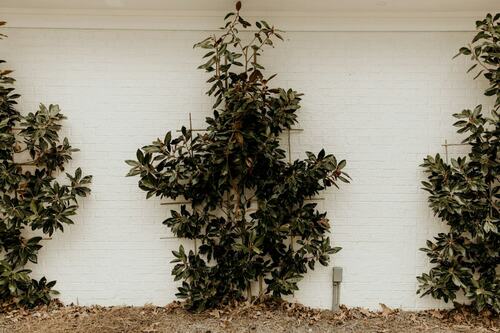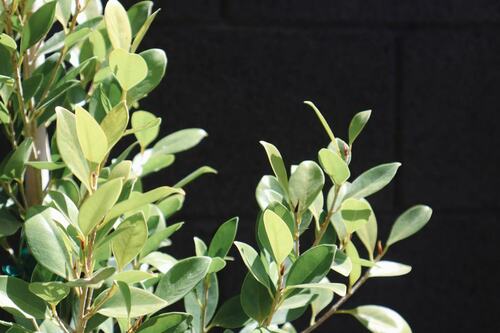The Ultimate Guide to Ficus Tree Care
Introduction
Ficus trees, also referred to as fig trees, artfully adorn the stunning landscape of San Francisco and surrounding communities. Take a stroll through the San Francisco Bay, and you are guaranteed to walk by at least a couple of ficus trees with gorgeous canopies. Common on Potrero, Lombard, and Hyde streets, the ficus trees feature dark-green leaves and lovely white trunks.
Though few know it, the versatile ficus tree can be grown both outdoors and indoors . The tree’s majestic aesthetic combined with its stunning green foliage makes it perfect for landscaping and shade canopies for a cool escape. This is your in-depth guide to caring for ficus trees.
Understanding Ficus Trees: Varieties and Their Unique Characteristics

Small Ficus Trees Line a White Brick Wall – Photo by Hannah Busing on Unsplash
There are variations of ficus trees throughout Southern California and beyond. The most common types of ficus trees are as follows:
- The Weeping Fig , also referred to as Ficus benjamina
- The Fiddle-Leaf Fig , also referred to as Ficus lyrata
- The Rubber Plant , also referred to as Ficus elastica
The overarching ficus genus has hundreds of species, though only a small number grow as houseplants. Ficus tree varieties include the popular trailing option that can fit in a hanging pot, taking form as a diminutive shrub. The alternative is a traditional ficus tree with lengthy branches.
The weeping fig is especially popular thanks to its signature drooping leaves. Though the weeping fig grows with ease, challenges inevitably arise when attempting to change its location. In general, ficus trees tend to remain healthy when permanently remaining in one spot.
Your ficus tree will thrive if you give it light, water it when the soil dries, and use a damp rag to eliminate monthly dust. Even moving the tree to a new corner of the room will likely cause it to lose some leaves. Once the plant’s roots reach three-quarters of the space in a pot, repot it to a container with at least two additional inches of diameter for proper accommodation.
Also, be aware that drafts from vents and excessive ficus tree watering will inevitably cause leaves to drop. Moreover, if you notice a significant number of weeping fig leaves dropping, reach out to the gas company, as excessive shedding is sometimes an indication of a gas leak .
Opt for a fiddle-leaf fig , and you’ll cherish this star of your home with the potential to reach six feet or taller. In particular, fiddle-leaf fig owners in San Francisco are to be mindful of its location. This fig variety doesn’t fare well with wind drafts, so be sure to position it in an area far away from an air vent, window, or door.
Choose a ficus rubber plant, and you’ll enjoy one of the toughest houseplants in existence. This short houseplant has sizable leatherlike leaves and an eye-catching upright stem.
Ficus tree watering has some nuances. As an example, fiddle-leaf figs should be watered at least once every 7-10 days. Be sure to give the fiddle-shaped leaves a light dusting once per month to eliminate tiny pests, including those dreaded spider mites that eat holes through leaves.
Choosing the Right Ficus Tree for Your Home: Weeping Fig, Fiddle-Leaf Fig, and More

A Potted Fiddle-Leaf Fig Tree – Photo by Mariana Rascão on Unsplash
The following ficus trees are commonly grown indoors:
- Fiddle-Leaf Fig
- Ficus Elastica
- Weeping Fig
Visit your local gardening store, and you’ll likely find the potted ficus trees are weeping figs. However, some stores carry other indoor ficus tree varieties, including the fiddle-leaf fig.
Keep in mind, the ficus has the potential to grow quite large and expand its dark leaf canopy. Several feet of room will be necessary both in terms of height and width. Insufficient space cramps the fiddle-leaf tree’s leaves to the point that it might not grow to its full potential and remain healthy. The weeping fig is especially temperamental, yet it will grow with sufficient light, water, and care.
Provide your indoor ficus with the appropriate amount of light, and it will thrive. If you change the plant’s position , it will likely drop its leaves, though there is the potential for new ones to grow. In general, ficus trees enjoy bright yet indirect light, so don’t shine a grow light immediately above it. If you opt for an outdoor ficus, position it in an area that receives six hours of direct sunlight.
When shopping for a ficus at the nursery or garden center, pay attention to the small stuff, as the subtleties of the trees matter a great deal. The healthiest specimens are those that are straight and scar-free. If you notice any warping, opt for a different specimen. The best ficus trees also feature rich, green leaves. Yellow or brown spots are signs of health issues.
Moreover, if the tree leaves have tears or rips, it is a sign that the tree is unhealthy. Don’t be afraid to touch the soil. Moist soil is a sign that the plant is sufficiently watered. Moreover, if you spot any bugs in the soil or on the leaves, opt for another candidate, as those bugs are a sign of infestation and potential damage. Above all, if there are indications of any leaf loss, take it as a warning that the plant is stressed and unhealthy.
How to Plant Ficus Trees: Step-by-Step Guide for Success

A Fig Tree Ready to be Planted – Photo by Feey on Unsplash
Now that you’ve selected your ficus tree, it is time to plant it. If there is Hessian wrap or other wrap, remove it, as it no longer serves a purpose post-shipping. However, if you are planting the tree in the middle of winter , and the temperatures are near freezing, it might be wise to leave the wrap in place.
Weeping figs thrive with soil that has ample drainage. The best growing medium is one that is fibrous and porous. You can also create your own growing medium with half peat and half sand. Though it is possible to grow a fig tree without fertilizer, it is better to use fertilizer that is water-soluble. The ideal potting soil is a combination of the following:
- Peat moss
- Loam
- Vermiculite
- Perlite
The soil should be moist at all times yet never waterlogged. It will likely take a couple of weeks or possibly a month or two for the roots to form. Transfer the plant to a sizable nursery pot with potting mix after a solid root system has developed. Be sure to change the water throughout the rooting process, as standing water will inevitably lose those vitally important nutrients.
Watering and Fertilizing Ficus Trees: Best Practices for Healthy Growth

A New Shoot on a Fig Tree – Photo by Jamshaid Mughal on Unsplash
Let’s shift our attention to growing ficus trees. Timely ficus tree watering is essential for ficus tree growth. Insufficient water or excessive water will stunt growth and hinder health. Regardless of whether your ficus is indoors or outdoors, sufficient water is necessary for a thriving plant. In general, it is best to water when the soil loses its moisture. However, your watering schedule should be amended if it appears the tree is waterlogged.
Excessive water inevitably leads to rotting roots. Alternatively, too little water results in leaves drying and falling. When in doubt, give the tree enough time to dry between waterings for sufficient drainage. Be mindful that the optimal water schedule for your ficus tree depends on its environment, its size, and the season. In general, a thorough ficus tree watering will be necessary once per week.
In terms of fertilizing , outdoor ficus trees grow best with all-purpose, slow-release granular fertilizer. Follow the fertilizer bag’s instructions for application. In general, fertilizer is most effective when sprinkled beneath the ficus and watered in.
Indoor ficus plants are best served with a liquid fertilizer or all-purpose fertilizer every couple of months in the fall and winter and once per month in the spring and summer. You can also fertilize once every two weeks during the spring growing season.
The best water-soluble fertilizers contain the following materials:
- Potassium
- Phosphorous
- Nitrogen
Though some weeping figs thrive without fertilizer, it is best to be on the safe side and add a water-soluble fertilizer once per month. Slow-release pellets are especially effective at the start of the growing season.
Optimal Light and Temperature for Ficus Trees: Ensuring the Right Environment

Illuminated Ficus Tree Leaves – Photo by Allison Astorga on Unsplash
The majority of San Francisco ficus trees thrive with indirect light. You can also illuminate ficus trees with filtered light. In general, a medium light level will suffice. If the light is too close to the tree or too bright, it will scald its leaves, causing loss.
Air drafts and low temperatures will compromise your ficus tree. In general, this tree variety should be exposed to temperatures at or above 60 to 70 degrees Fahrenheit. Position the trees far away from windows and doors to prevent cold drafts from causing damage.
Be mindful of the plant’s exposure to moisture in the form of humidity. Optimal ficus tree care is characterized by an environment with 40 percent relative humidity. Excessive humidity will hinder sufficient growth. Keep in mind that more humidity and ficus tree watering will be necessary in correspondence with increasing light and temperature. However, ficus plants should not be exposed to more than 60 percent humidity. You can maintain humidity levels of 50 percent with consistent misting.
Ficus tree owners should be aware that weeping figs are especially sensitive . The weeping fig is delicate, meaning it is highly sensitive to alterations in both temperature and light. If you own a weeping fig, position it in an area away from direct sunlight and air drafts. Never position a ficus tree of any variety near a window without blinds or curtains, as those barriers are necessary to filter out the harmful sun rays.
Pruning and Shaping Ficus Trees: Techniques for Health and Aesthetics

Healthy Fig Tree Leaves at Sunset – Photo by Marta Wave
Proper pruning keeps ficus trees healthy and properly shaped. A combination of hard pruning and slight shaping brings out the best in tree aesthetics. Twisting with bonsai techniques is also an option. The optimal time to prune, twist, and shape the tree is in the early spring at the start of the growing season.
Weeping fig trees tend to grow best when slightly rootbound. If there is excessive root binding, the leaves will decrease in size and the plant won’t grow properly. In such an instance, the plant will require repotting in the spring or winter.
Ficus trees have the potential to become “leggy,” meaning they sometimes have wayward growth. If you notice any leggy growth, trim it back right away. The trimming of leggy sections will prompt the quick sprouting of new leaves. Be sure to wear gloves and use sterilized pruning scissors when pruning ficus trees.
If you notice any dust on your ficus tree leaves, wipe it away to maintain clear pores. Otherwise, the leaves won’t properly absorb moisture. Resist the temptation to use wax-based cleaning solutions on the tree’s leaves, as those concoctions will cause the pores to clog.
Common Pests and Diseases of Ficus Trees: Identification and Treatment
Spider mites have the potential to eat holes in your precious ficus tree’s leaves. Other small but very real threats to your ficus tree include scale insects and aphids . However, you might not be able to identify these pests with the naked eye, as they are miniscule.
If you notice sap dripping from your ficus plant, be aware that it is honeydew resulting from an invasive pest and indicates an infestation. Apply neem oil to the plant to mitigate pest problems.
Diseases are also a threat to ficus trees. Bacteria prompts disease that manifests in the form of crown gall and leaf spots. Fungus can also prompt disease. As an example, root rot is a fungal disease that causes ficus tree roots to rot, eventually leading to death.
You can minimize the chances of disease with the following strategies:
- Sufficient watering
- Optimal air circulation
- Proper fertilization
- Fungicides
- Pest control
- High-quality soil
- Timely pruning
The Ficus Tree is the Perfect new Addition to Your San Francisco Home or Landscaping
If you live in or near the San Francisco Bay Area, a ficus tree is must-have. Beautify your home’s interior or exterior with the addition of a new ficus and you’ll find it adds visual flair and uplifts the spirit. The best part is that you get all the benefits of a ficus tree without an exorbitant financial cost or excessive maintenance.
We invite you to check out our blog for more information about the ficus tree and other plants, trees and greenery commonly grown throughout San Francisco. Be sure to subscribe to our newsletter for the latest information, and contact Arborist Now today for help with choosing, planting, and caring for all of your beloved trees!


